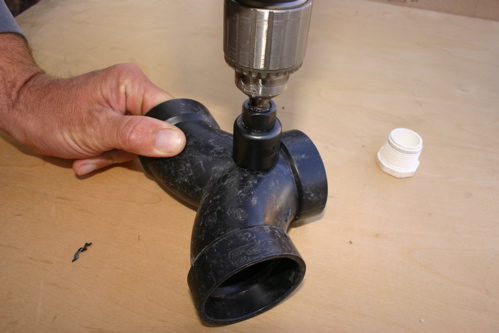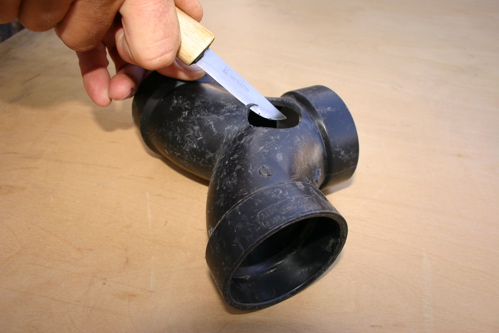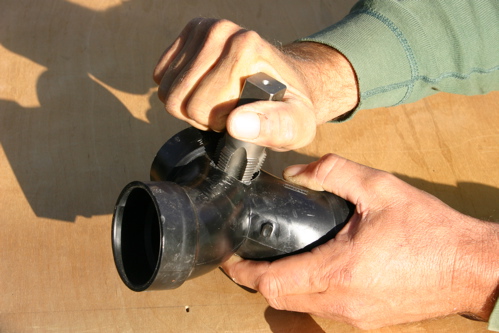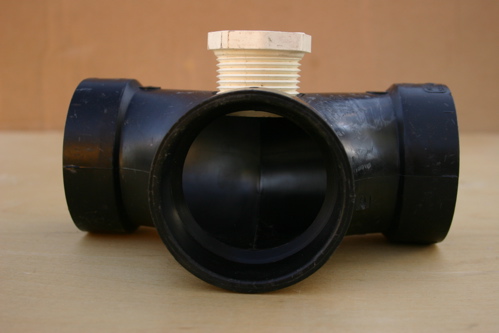How to Make A Flow Splitter w/ Threaded Inspection Hole & PVC Plug
Flow splitters with inspection holes and plugs make cleaning out clogs easy…
The following is adapted from, and meant as a supplement to, chapter 12 of Rainwater Harvesting for Drylands and Beyond, Volume 2, 2nd Edition
When I build branched-drain greywater systems, I install flow splitters with inspection holes. With greywater flowing, I can remove the plug in the inspection hole to observe the flow and twist or adjust the angle of the flow splitter until I get an even flow split. The flow splitter is the one piece of greywater plumbing that is fit snugly into place — NOT glued — so I can adjust it as needed. If the flow splitter is below grade, I install it in an irrigation valve box to get the needed access. Flow splitters with hole and plug can be purchased ready-made at www.oasisdesign.net/catalog or you can follow the directions below to make your own.
1. Drill a starter hole in your flow splitter with a 1/8-inch (4-mm) drill bit.
2. Widen hole with a 1-1/8-inch (29 mm) hole saw (fig. 1).

Fig. 1. Drilling inspection hole in a double L flow splitter with a hole saw bit on a drill
3. Carefully carve a taper into the upper lip of the hole. Do not carve the lower lip of the hole. When you are finished, the upper lip of the cone-shaped hole is wider than the lower lip of the hole, making a sharper hole edge into which a threaded plug can take hold (fig. 2).
 Fig. 2. Carefully carving a taper into the upper edge of the hole Note: You can also buy a tap from your local hardware store that will thread the hole to your desired thread size, but the cost may not be justified if you are making only one or two flow splitters (fig. 3).
Fig. 2. Carefully carving a taper into the upper edge of the hole Note: You can also buy a tap from your local hardware store that will thread the hole to your desired thread size, but the cost may not be justified if you are making only one or two flow splitters (fig. 3).

Fig. 3. Threading the hole with a tap. Often you can turn the tap by hand, but use a wrench if extra leverage is needed. For a method that does NOT require threading of the hole or a threaded plastic plug see here. 4. Place a 1-inch (25-mm) diameter threaded PVC plug atop the hole to see if the hole is acceptable. Adjust the hole as needed, then carefully screw the plug straight into the hole. Screw it in only far enough to stay in place, not so far that it could block water flow in the pipe (fig. 4).
 Fig. 4. PVC plug screwed in place without blocking water flow in pipe Note: Whenever possible, use a double L-type flow splitter instead of a Y-type. The double L-type splits a range of water flows evenly and predictably, while the Y-type often sends more water down the straight run than the branch of the Y. However, it is possible to array plants with the uneven flow of the Y-type in mind by placing a more water-needy plant downslope of the straight run and a less water-needy plant downslope of the branch of the Y.
Fig. 4. PVC plug screwed in place without blocking water flow in pipe Note: Whenever possible, use a double L-type flow splitter instead of a Y-type. The double L-type splits a range of water flows evenly and predictably, while the Y-type often sends more water down the straight run than the branch of the Y. However, it is possible to array plants with the uneven flow of the Y-type in mind by placing a more water-needy plant downslope of the straight run and a less water-needy plant downslope of the branch of the Y.
For more

Volume 2
See chapter 12 of Rainwater Harvesting for Drylands and Beyond, Volume 2, 2nd Edition, available at deep discount direct from the author and the “New Create an Oasis with Greywater” by Art Ludwig found at www.OasisDesign.net.
